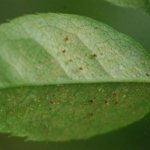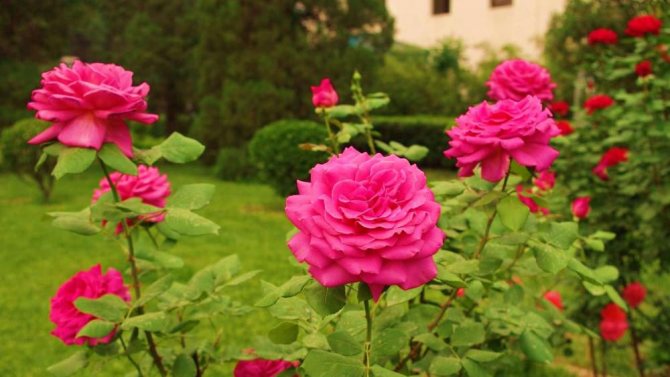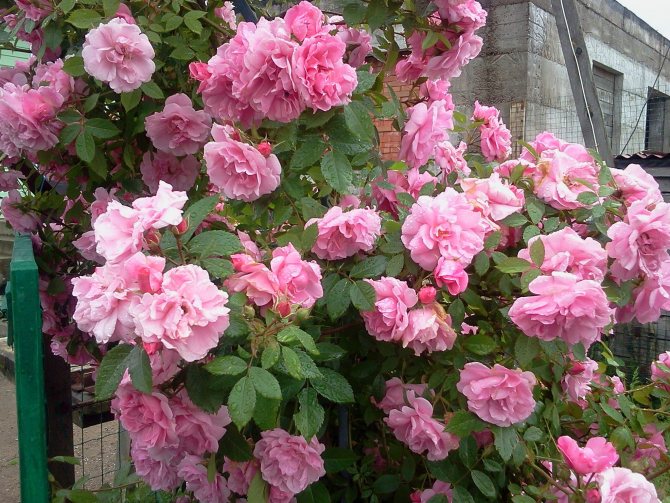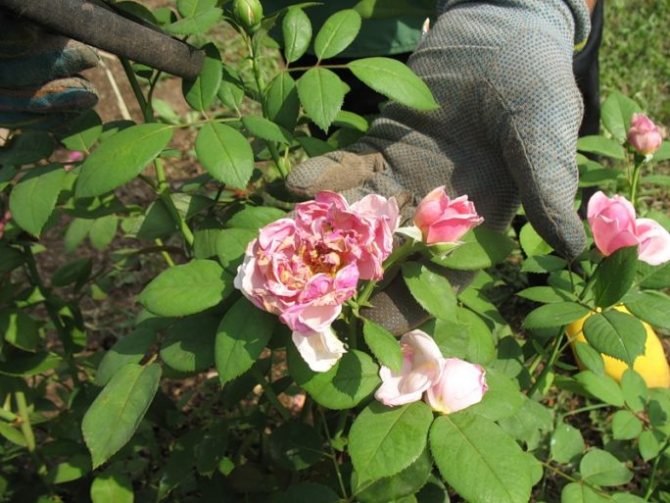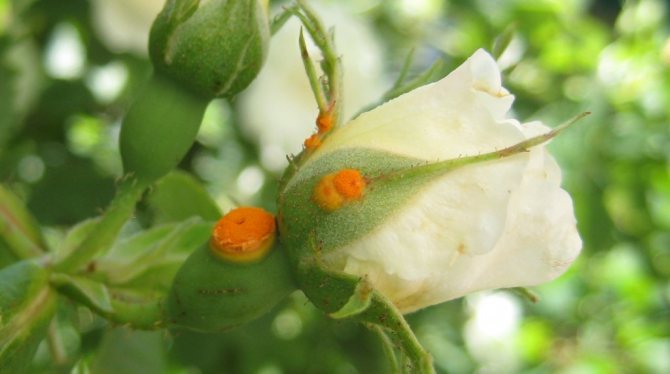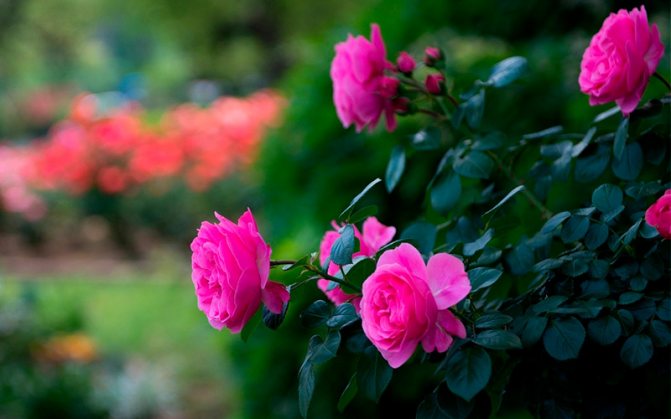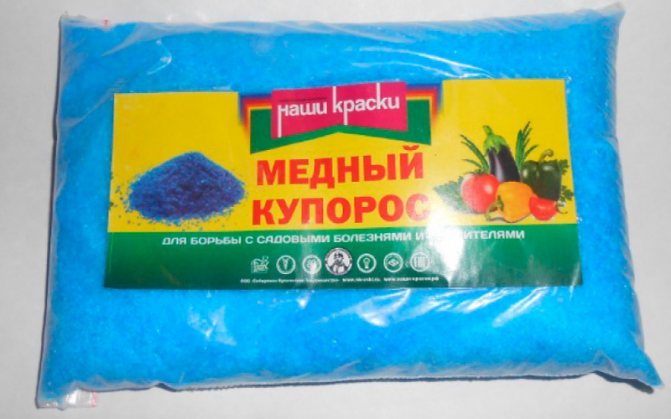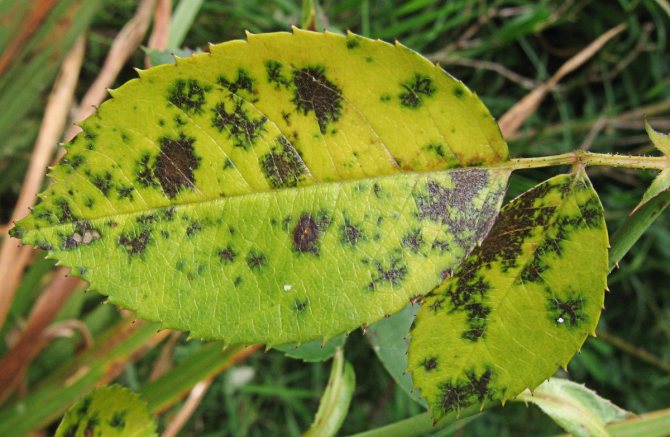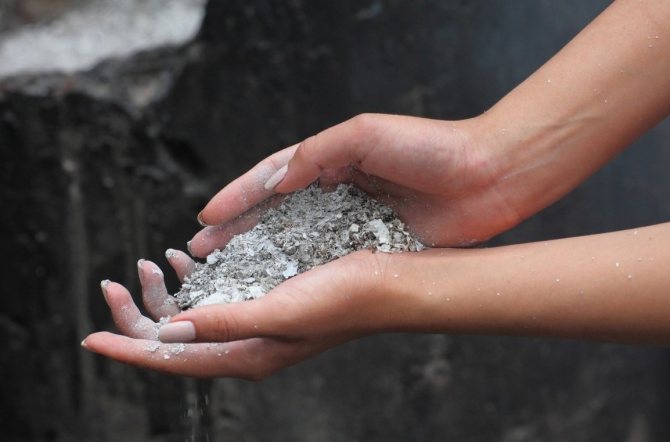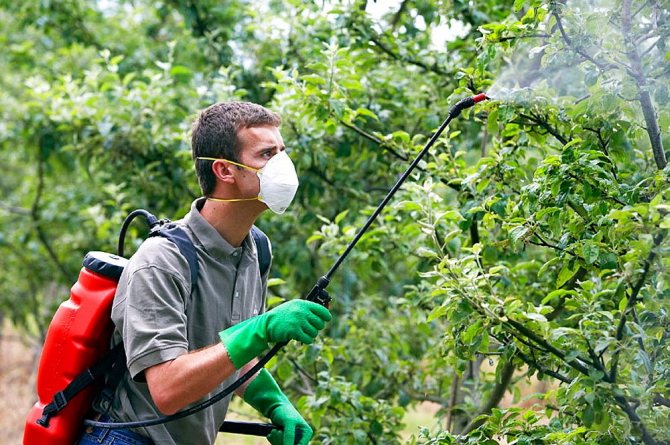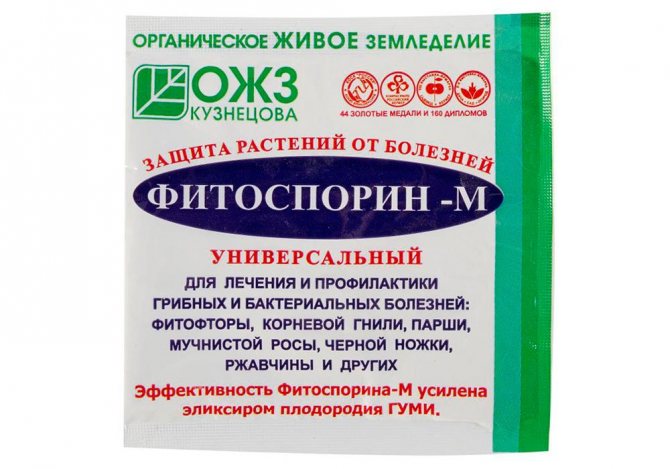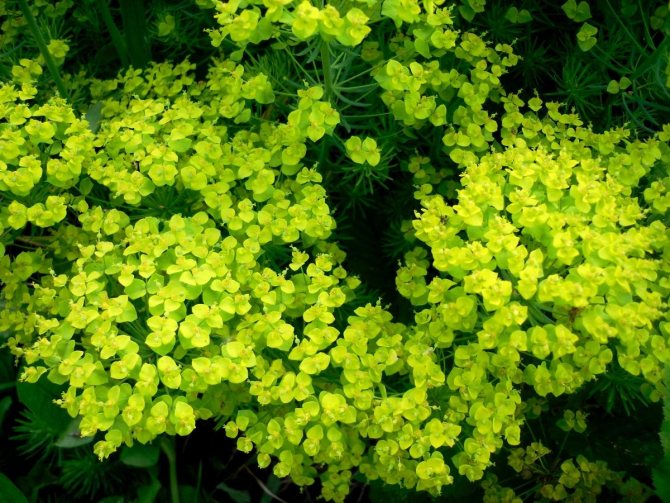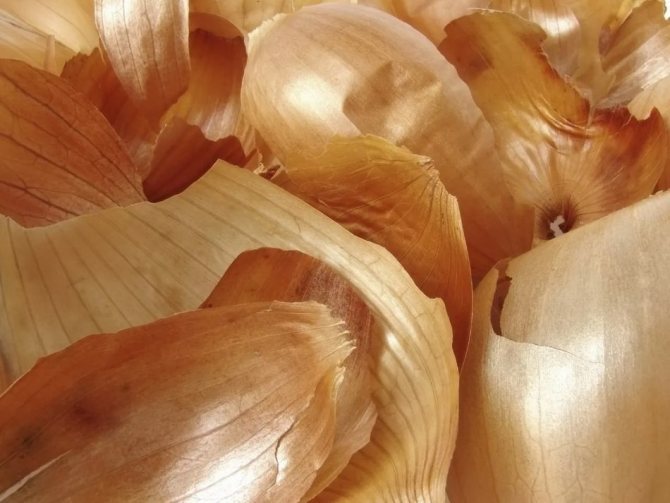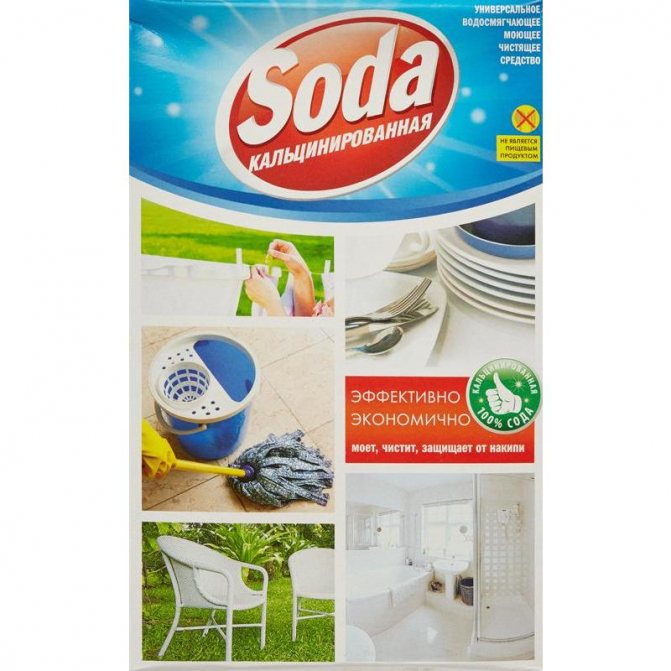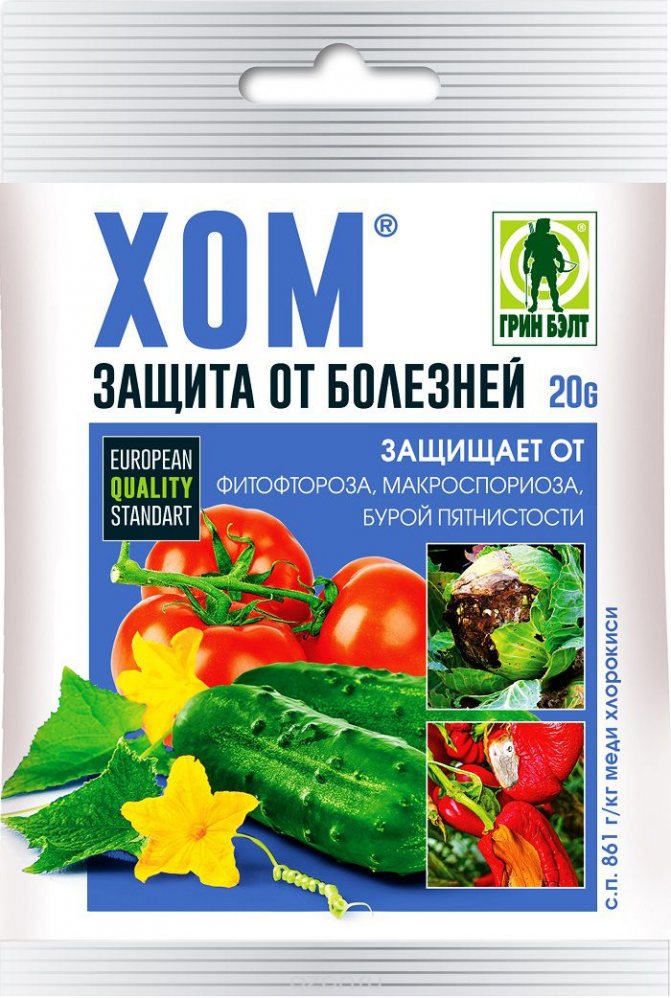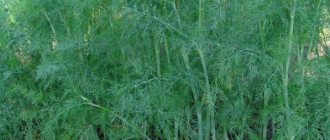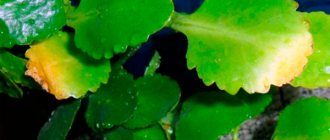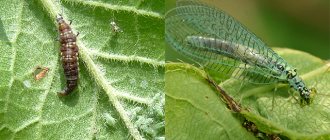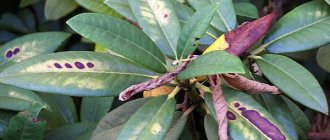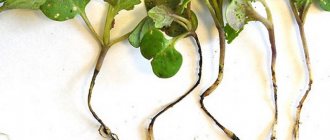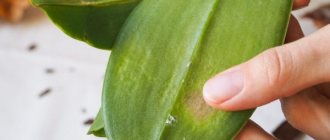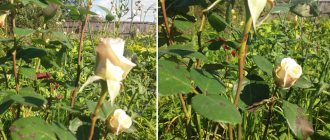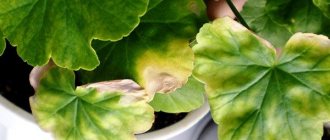In the entire European part of Russia, it is quite difficult to find a garden or summer cottage plot with a flower garden on which several rose bushes would not be grown. Such universal recognition and love of flower growers are explained, first of all, by the attractiveness of the cultivated species, the long flowering period and the variety of varieties. But in order for flowering bushes to retain their spectacular attractiveness and decorative qualities, they need constant comprehensive care. The fight against pests of roses is just one of the components of this complex of activities.
Prevention and treatment:
Autumn pruning of affected shoots, collection and burning of fallen leaves. Digging the soil with the circulation of the layer - while the causative agents of the disease die from a lack of air in the soil.
1:1593 1:4
In autumn or early spring (before bud break) after pruning affected shoots and harvesting fallen leaves sprayed with solutions: 3% ferrous sulfate with 0.3% potassium sulfate or 3% copper sulfate.
1:374 1:379
During the growing season, excluding the flowering time, they are regularly (after seven to ten days) sprayed with other preparations.
1:592 1:597
For example, with a copper-soap solution: Dissolve 200-300 g of liquid green soap (or 72% household soap) in 9 liters of soft water (preferably rainwater); Dissolve 20-30 g of copper sulfate in 1 liter of water; quickly stirring the soap solution, pour a solution of copper sulfate into it with a small stream. The solution is ready for use.
1:1138 1:1143
For spraying, a 1% suspension of colloidal sulfur is used. Sulfur has a stimulating effect on the growth and development of roses, especially on alkaline soils. This is apparently due to its oxidation and the subsequent increase in water-soluble reserves of nutrients in the soil.
1:1650 1:4
Unilateral application of nitrogen increases the development of the disease.
1:115 1:120
Top dressing with potash fertilizers increases the resistance of roses to powdery mildew.
1:266 1:271
With a strong development of the disease, you can spray the plants with soda ash (50 g per 10 l of water).
1:449 1:454
Also, in autumn and spring, the soil around the rose bushes sprinkled with wood ash (100-120 g per 1 m²) and slightly embedded in the surface layer.
1:708 1:713
Once every seven days in the evening, sprayed with a five-day infusion of ash (200 g per 10 liters of water) and mullein (1 kg per 10 liters of water). Microelements found in ash and slurry, bacteria destroy the mycelium of the pathogen of powdery mildew and contribute to the healing of roses. Thus, a biological method of control and foliar feeding is carried out. Spraying is repeated until the symptoms of the disease disappear.
1:1436

2:1991 2:4
The leaves are dotted with translucent or pale yellow specks. A thin cobweb is visible on the underside of the leaves and on the petioles, which means that one of the most dangerous pests has settled on the rose - the spider mite.
2:373
Adult ticks have four pairs of legs, their body is oval, 0.3-0.5 mm long, greenish-yellow in color with black spots on the back.
2:615
Winter body coloration is orange or red. The larvae are greenish with three pairs of legs. Eggs are small, up to 1 mm in diameter, round, transparent, located under a thin web.
2:929
One female lays up to 180 eggs. After five to seven days, larvae emerge from the eggs.... The entire developmental cycle of a tick is 10-25 days. An adult tick lives for 18-35 days.
2:1218 2:1223
The pest spreads in dry hot weather. Both adult mites and their larvae damage the leaves of roses from the underside, suck out the juice from the leaves, the affected leaves turn yellow, become covered with small light spots at the injection sites and fall off prematurely.
2:1691
Spider webs and excrement secreted by pests pollute the leaves, a lot of dust is retained on the latter... As a result, roses lose their decorative effect.
2:275
Females hibernate mainly under plant debris, in greenhouses - under lumps of soil and in other secluded places. In spring, at an air temperature of 12-13 ° C, females lay barely noticeable transparent creamy eggs on the underside of the leaves. In winter greenhouses, ticks live and multiply constantly. Often, inexperienced rose growers complain about the yellowness of the leaves of roses, attributing various diseases to the plants (chlorosis, etc.). In fact, this is the work of spider mites. You can find them with a magnifying glass.
2:1201
Rules for processing roses
Rose spray preparations require proper application. Be sure to clear the area from fallen leaves, last year's debris. For procedures, choose warm, calm weather. Morning or evening activities will protect you from the scorching rays of the sun.
Preparation for spraying roses
Fertilization will provide plants with nutrients and improve immunity. In the spring, the rose is fed with a solution of urea and chicken droppings. Of mineral preparations, a mixture of superphosphate and potassium sulfate works better. The liquid is carefully poured under each bush.
Processing technique
Protective measures against insects and diseases are carried out by spraying. The chemical is diluted in a spray tank, shaken thoroughly. For processing, you need a nozzle with a fine drop. The solution is abundantly covered with roses, the ground in the root circle.
Spring treatment calendar for diseases and pests
Seasonal work for the bushes begins after the cover is removed. After 3 days, the plant is examined, pruned and the roses are sprayed with iron vitriol from fungi. After 24 hours, the crops are supported with complex fertilizers. A week later, the first treatment for insects is allowed, the second is transferred to the 20th day.
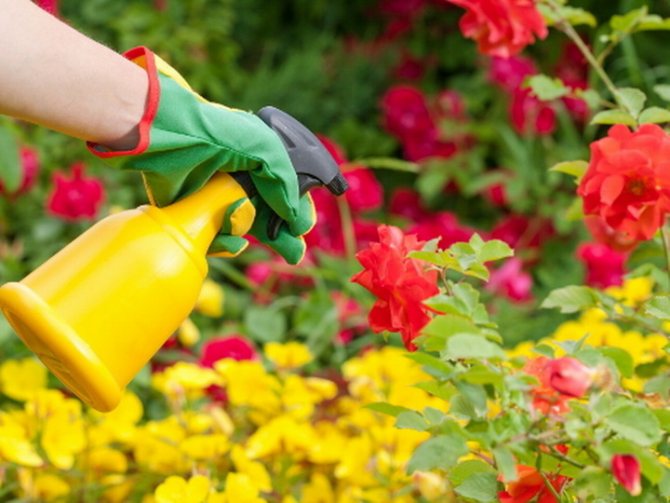

Prevention and treatment:
Regular watering, in case of mass defeat - spraying with an insecticide. Spraying plants with acrex at a concentration of 0.08% or isophene - 0.05, omite - 0.1% and other acaricides. The development of mites is inhibited by spraying with cold water on the lower surface of the leaves 3-4 times a day.
2:1761
In greenhouses, the most harmless are preparations of the avermectin group: aktofit, fitoverm, vermitek. These drugs do not act on eggs and tick larvae and protonymphs that do not feed, expect to molt. At a temperature of +20 ° C, at least 3 treatments are required with an interval of 9-10 days. At +30 ° C 3-4 treatments with an interval of 3-4 days.
2:609 2:614
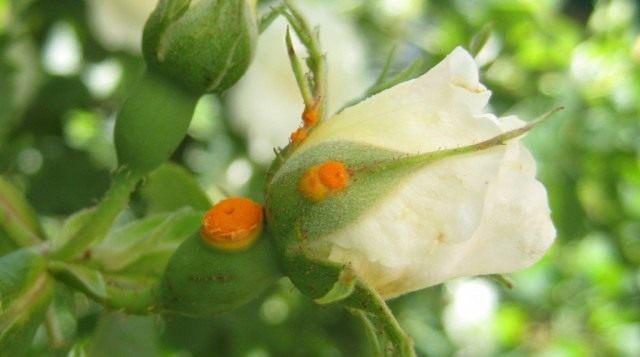

3:1142 3:1147
In spring, an orange dusty mass of spores appears on the stems near the blossoming leaves and root collar. In summer, small orange-yellow sporulation pads are visible on the underside of the leaves. The disease of roses with rust is more pronounced in years with warm and humid springs. With the development of rust, the plants are oppressed, the leaves dry out, the stems, shoots and flowers are deformed.
3:1842
Preparations against rose pests
Universal drugs:
Aktara (thiamethoxam) - a broad-spectrum insecticide, absorbed into plant tissues, quickly penetrates the stem and leaf, is very effective in combating rose pests.
DOES NOT work on ticks! Very well suited for the protection of young shoots from the pest "Downward sawfly".
Neoron (bromopropylate) - a highly effective agent for combating all types of ticks. It is well tolerated by roses when treated against pests, but does not affect other insects, does not leave stains on the leaves.
Other drugs and analogues:
If the recommended preparations are not found for the treatment of roses from pests, analogues consisting of the same active substance are quite suitable, for example:
| A drug | Analogue against pests of roses |
| Alphamethrin | Alfatox, Geletrin, Fastak, etc. |
| Deltamethrin | Deltar, Decis, Kotrin, Oradelt, Politox, FAS, etc. |
| Permethrin | Ambush, Talkord, Corsair, Permasekt, City, etc. |
| Pyrethrins with organophosphates | Tornado, Ultimatum and others |
| Tetramethrin | Neopinamine et al |
| Fenvalerate | Sumicidin, Fenax, Fenaxin, Sorcerer, Mashenka, etc. |
| Cyhalothrin | Karate |
| Cypermethrin | Inta-vir, Arrivo, Tsimbush, Mikron, Microcin, Nurel, Ripkord, Tsimbush, Tsinoff, Tsipershans, Tsitkor, Sherpa, etc. |
| Esfenvalerat | Sumi-alpha. highly effective product with low consumption rates. |
| Alpha-, Beta-, Zeta-, etc. cypermethrins | Fastak, Kinmix, Fury, etc. |
Prevention and treatment:
Do not plant the bushes closely, leave enough space for airing. Cut off affected shoots, harvest leaves, and burn them. Also useful are soil digging, spraying roses before shelter for the winter with Bordeaux liquid or iron vitriol. During the growing season, it is treated with a copper-soap solution. If the rust continues to spread, then the diseased plant will have to be burned.
3:775 3:780
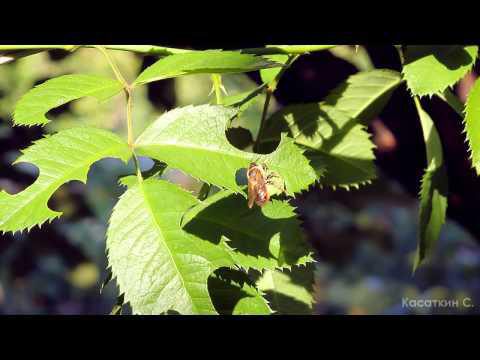

4:1320 4:1325
Large, regularly rounded bites on the edges of old hard leaves were made by a bee living in an earthen burrow to seal the honeycomb with larvae.
4:1604
Spring processing of roses from pests and diseases
Correct organization of seasonal work will protect flowering bushes from diseases and parasites. Comprehensive spring care is a must not be missed. Compliance with growing requirements will help you get a healthy ornamental plant.
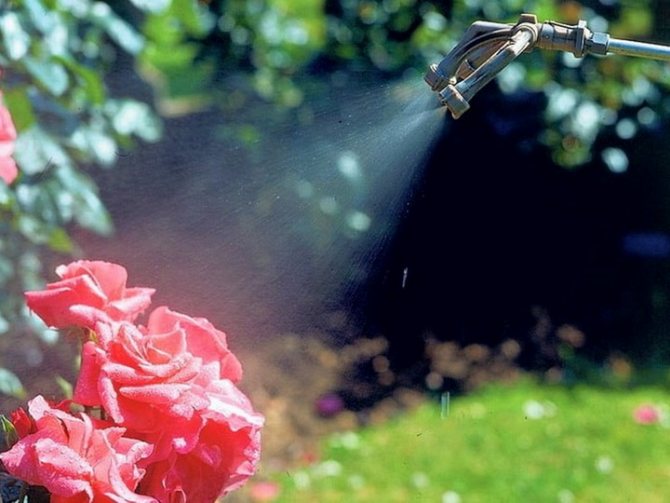

Removing the protective cover from roses in spring
For the winter, caring gardeners prefer to shelter rose bushes. The optimal time for removing protection is determined by the average daily temperature (from +5 ° C). At night, the temperature indicator should not fall below -4 ° С, and during the day - keep within +10 ° С. If you remove the winter fence early, the bushes will freeze. Late procedures can provoke damping roses.
Unrolling of plants
The soil near the trunk at high humidity will become a catalyst for decay and the appearance of mold. Microorganisms enter the tissue of the rose, gradually destroying healthy parts. In March, the protective soil layer is carefully removed by hand, trying not to damage the shoots. The remaining dirt is washed off with a stream of warm water from the watering can.
Prevention and treatment:
The bee will not bring much harm, so you better be glad that this rather rare insect has settled in you.
4:257 4:262
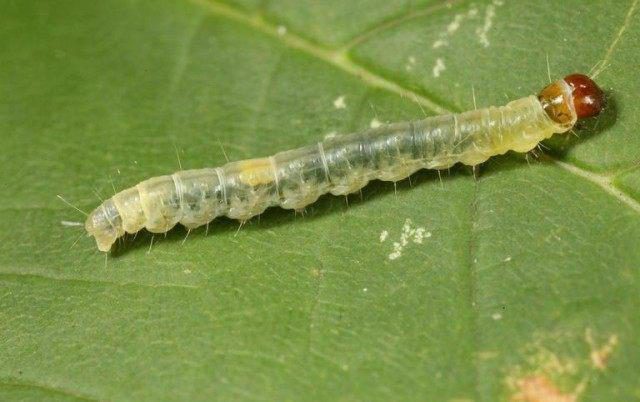

5:793 5:798
Caterpillars of three types of rose leaf rollers and a fruit roller do great harm to the leaves and young shoots of roses. The first caterpillars appear in early spring, damaging barely blossoming buds, then young shoots and leaves.
5:1218
Control measures:
With a small dispersal of leaf rollers, caterpillars are collected by hand and destroyed. In the spring, before bud break, the bushes are sprayed with one of the pesticides.
5:1527 5:4
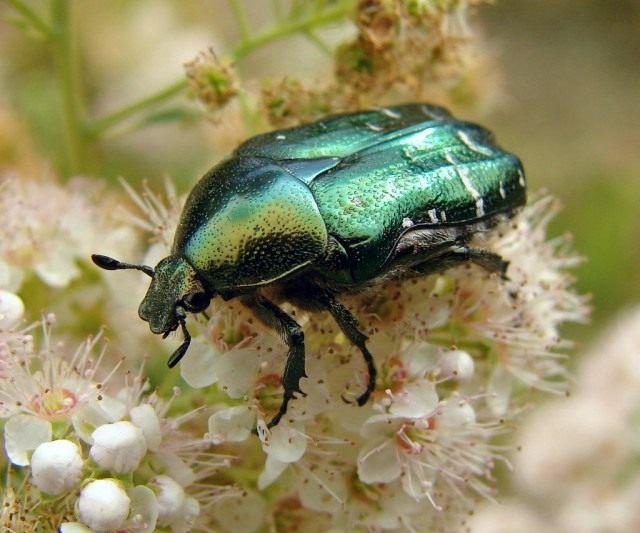

6:550 6:555
Bronzovka beetles are golden-green above with sparse hairs, copper-red below. Their body length is 15-20 mm. Beetles fly from May to August. Females lay their eggs in humus-rich soil, in manure. At the end of summer, the larvae pupate in the soil, beetles emerge from them, which hibernate there, and fly out the next summer.
6:1109 6:1114
Fawn - black beetles, densely covered with grayish hairs with white spots, the body length of the beetle is 8-12 mm. Both beetles eat the petals of rose flowers, eat out stamens and pistils. Flowers of light colors suffer more from them.
6:1512 6:4
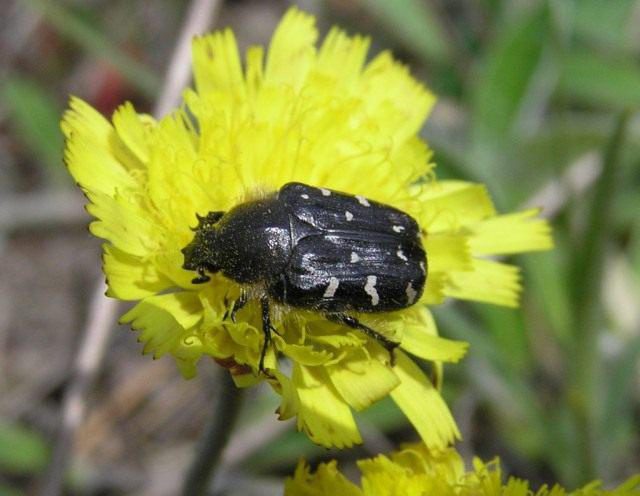

7:508
Folk remedies for spring treatment of roses
Toxic drugs quickly destroy pests and diseases of roses. If the flowers are grown for culinary or medicinal purposes, then you will have to use safe options.Folk remedies prevent the appearance of a problem, eradicate it in the early stages.
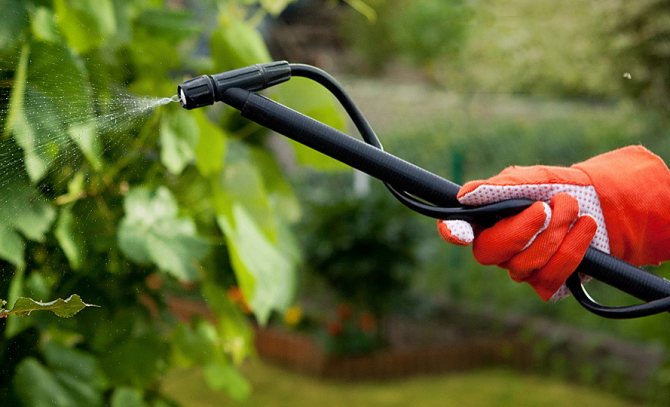

Against powdery mildew
The ash and manure mixture helps to get rid of the beginning powdery mildew. In 10 liters of water add 200 g of crushed charcoal and 1 kg of fresh organic matter - cow dung. The solution is left to infuse for 7 days, sometimes stir with a stick. Filter the finished liquid, treat the affected bushes. To enhance the effect, alternate with biofungicides.
From rust
Euphorbia helps to get rid of the disease in the initial stage. A few spots are smeared with fresh plant sap. If the disease has spread to the rose garden, then use a water extract. 2 kg of raw materials (roots, foliage and stems of the medicinal type) are crushed, poured with a bucket of warm water. After 24 hours, the bushes are sprayed.
From pests
To scare off parasites, you need to plant useful plants next to the roses. Pests do not like the smell of marigolds, sage and calendula, so they will bypass the site. If insects appear, then leaf treatments with water infusions will help drive them out:
- tobacco dust;
- dry wormwood;
- chopped fresh sorrel roots;
- capsicum.
Before you spray roses in the spring for diseases and pests, you need to choose the best remedy. Seasonal activities begin after the protective structures have been removed and before the buds appear. Grateful plants will delight the gardener with abundant color.
Control measures:
Collect beetles early in the morning when they sit motionless on flowers.
7:652 7:657
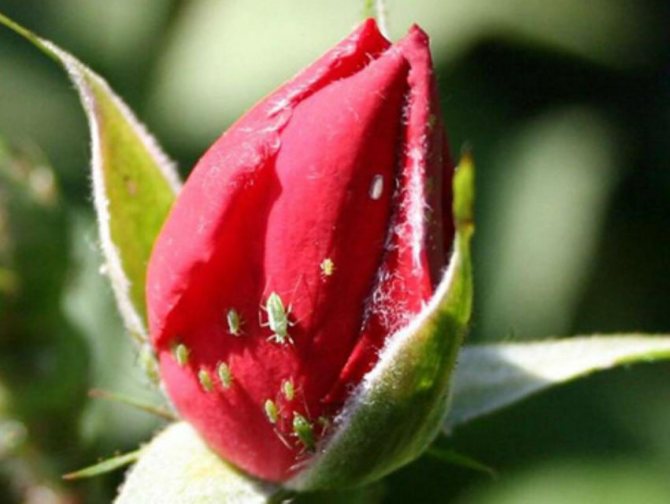

8:1174 8:1179
Colonies of tiny black or green insects sucking juices from young shoots and buds. It settles on rose bushes in large colonies, located on the underside of the leaves, on the stems of young shoots, buds and peduncles.
8:1609 8:4
Aphid larvae are very small, barely visible to the eye. They quickly turn into wingless large founding females, which immediately produce about a hundred larvae, the latter, in turn, in eight to ten days are able to give new offspring. Only ten or more generations a year. The generation of one aphid during the growing season can give about two million individuals.
8:665 8:670
By the end of summer, winged forms of aphids appear - males and females. They lay fertilized hibernating eggs, from which new colonies of aphids emerge in early spring. By sucking the juice from the young organs of roses, insects grow and reproduce quickly.
8:1106 8:1111
Bushes weakened by aphids do not grow well, shoots are often bent, leaves curl and crumble, and the buds do not open or give ugly flowers. Roses weakened by aphids do not tolerate wintering conditions worse.
8:1493 8:1498
The appearance of aphids on roses can be judged by the increased activity of ants in the rose garden, who drink the sweet juice secreted by aphids. Ants protect the colonies of aphids and even organize new colonies, transferring the founding females to places not yet inhabited by pests.
8:484
What diseases affect roses in spring
There are many diseases that affect roses in the spring. To quickly cope with diseases, you need to know their signs.
Leaf rust
If the spring is rainy and warm, roses can rust. This disease affects both leaves and stems, it appears during flowering. Orange spores appear near the leaf blades. In summer, orange pads form on the back of the leaves, which have an extremely negative effect on the entire bush: metabolism and photosynthesis are disrupted. With a strong defeat, the flower loses its decorative appearance, diseased leaf plates completely turn yellow and fall off.
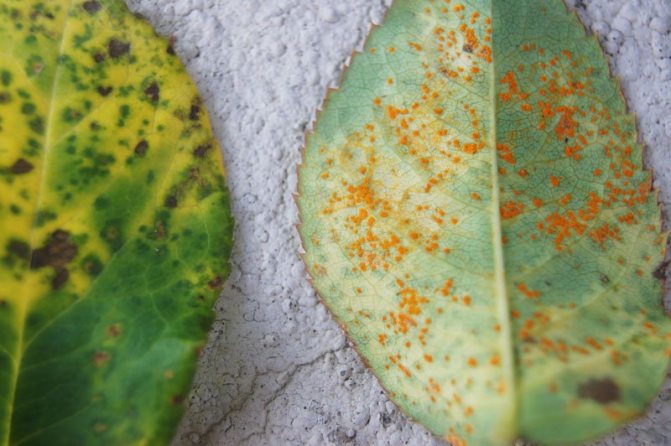

Rusty rose leaves.
Gray rot
With this disease, leaves, tops of stems and buds, which are covered with a fluffy gray bloom in wet weather, most often suffer. The disease primarily affects weakened bushes with light pink or white flowers.
In such plants, the buds do not open, they begin to rot and fall off. The petals are covered with small brown spots, the leaf plates turn yellow and fall off.
The focus of infection is located in various parts of the rose in the form of a mycelium, which forms spores with the onset of heat. They are carried by the wind and insects.
Gray rot can be observed on neglected plantings, or if the plant was watered late in the evening and it did not have time to dry out by night.
Powdery mildew
Powdery mildew spores are carried by the wind and often infect roses with weakened immunity. Signs of the disease include a dense, filamentous white bloom that covers leaves, shoots and buds. If the disease begins to progress, the plaque becomes gray. On various parts of the plant, spores of the fungus ripen, which are carried by the wind. They can infect nearby bushes. In a sick rose, flowers, leaf plates and shoots dry up and fall off. Powdery mildew spreads in hot and dry weather.
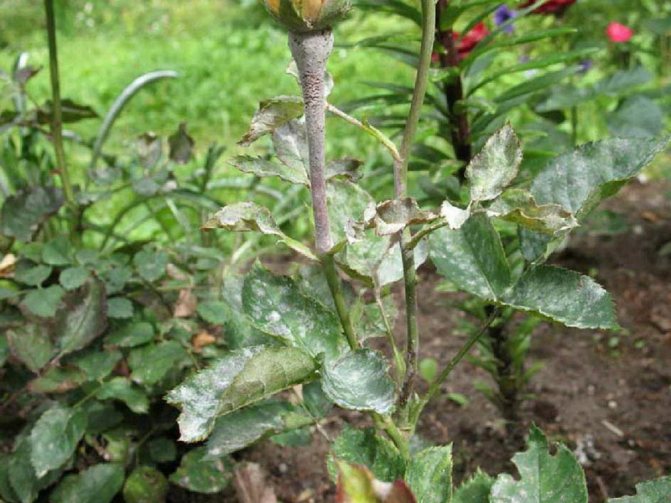

Powdery mildew on roses is characterized by a white bloom.
Black spot
In early spring, the rose may develop black spot. The spores of the fungus, once on the crop, infect the plant. The disease manifests itself in the form of dark spots on the surface of the leaf, which gradually grow. After a while, they turn black. The completely affected leaf plate begins to curl, dry out, and then falls off. The shoots of the plant are exposed, it stops blooming, weakens and dies.
High humidity and low air temperature contribute to the rapid spread of spores.
Prevention and treatment:
Spraying in early spring, before the buds swell, with a soap-ash suspension, insecticides, destruction of ant nests in plantings, which serve as breeding grounds for aphids.
8:831 8:836
Later, one of the following insecticides is used: actellic, antio, karbofos, metathion, rogor and others. Spraying with a solution: 2 g of kerosene per 10 liters of water.
8:1113
An infusion of the following composition is also effective: 300 g of chopped onion or garlic and 400 g of tomato leaves are placed in a three-liter jar. The latter is filled with water and placed in a warm place for 6 hours to infuse. After that, the infusion is mixed well, filtered through cheesecloth or a fine mesh and in a large bowl, bring the volume to 10 liters with water. To make the infusion adhere well to the leaves and shoots, add 40 g of 72% soap, but better - liquid green.
8:1916
Bushes are treated with this infusion every seven days in five repetitions. It can also be used against ticks, copperheads, sawflies, caterpillars.
8:279 8:284
Aphids are eaten by many predatory insects, for example, ladybugs, lacewings and their larvae. One ladybug can eat up to 270 aphid larvae per day
8:553 8:558
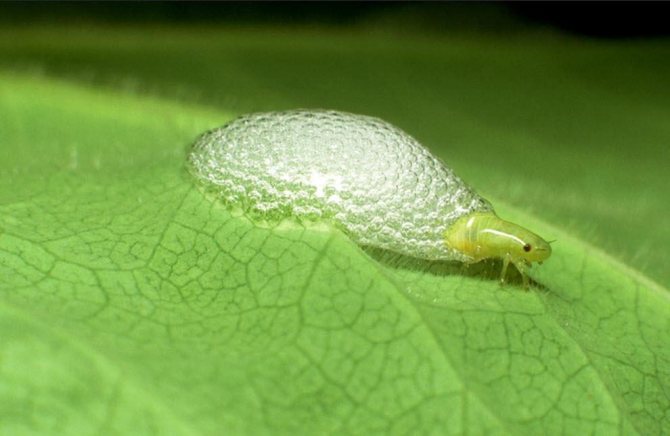

9:1139 9:1144
A small foamy formation on the stem, inside which the leafhopper insect larva sits. The body of an adult insect is yellow-gray in color. The larvae live in their frothy secretions in the form of salivary foam, sucking the juice from the stems. They are located in the axils of the leaves and on their lower side. When touched by the leaves infested by the pest, the larvae quickly jump out of the foam and hide. There is no particular harm from it, but this larva, like many sucking insects, can serve as a carrier of viruses.
9:2058
What fungicides to use in spring?
Immediately after the opening and sanitary pruning of roses, the first treatment is carried out against pathogens of fungal diseases. More often, the treatment is called "blue spraying", it is carried out with Bordeaux liquid or only 3% copper sulfate. Iron sulfate with the addition of potassium sulfate is also used for prevention (combine 3% and 0.3% solutions, respectively).
Other industrial fungicides are often used.
- "Abiga-Peak" inhibits pathogens of powdery mildew, rust, spots, rose bacteriosis, while being safe for pollinating insects, beneficial inhabitants of the soil.For spraying, 40 g of the drug is dissolved in 10 liters of water.
- Oxyhom is a drug of similar action. It is quickly absorbed into tissues without the risk of being washed away by the spring rain. The working solution is prepared from 60 g of the product and 10 liters of water.
- "HOM" prevents the main diseases of roses. It is easily washed off by rain, therefore, it is used when the weather forecast is favorable. Safe for the beneficial residents of the rose garden. The spray solution is prepared from 40 g of fungicide and 10 liters of water.
- "Kuprolux" is highly effective against rust, various types of stains, powdery mildew. The composition includes two active substances: cymoxanil quickly penetrates the tissues, copper oxychloride protects the rose from the outside. 25 g of the product is stirred in 10 liters of water and the bushes are treated with a solution.
All drugs are diluted in strict accordance with the instructions, an overdose negatively affects both the condition of the roses and the viability of beneficial insects.
After 15 days, the roses are sprayed again to consolidate the effect of the drugs.
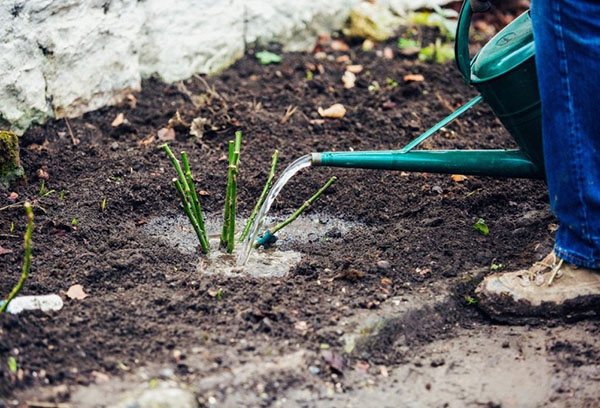

Prevention and treatment:
Cover bushes during heavy rains, use fungicides, and thin bushes to remove weak and rotten branches.
10:1221 10:1226
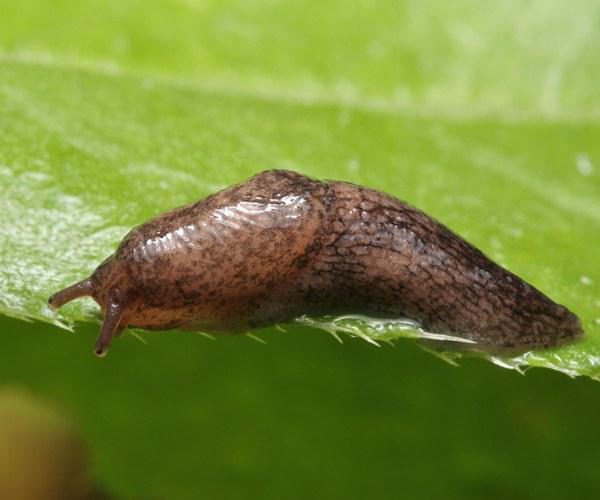

11:1781 11:4
They, and similar creatures, are happy to feast on young rose leaves, gnawing them completely or only the soft parts. Plants weaken and lose their decorative effect.
11:318
Prevention and treatment:
Disinfect the instrument when cutting flowers. Keep your rose planting clean. Remove the affected stem completely and burn, cover the cut with hot garden varnish, remove the mulch and topsoil around the perimeter of the bush and replace them with fresh ones.
12:1862
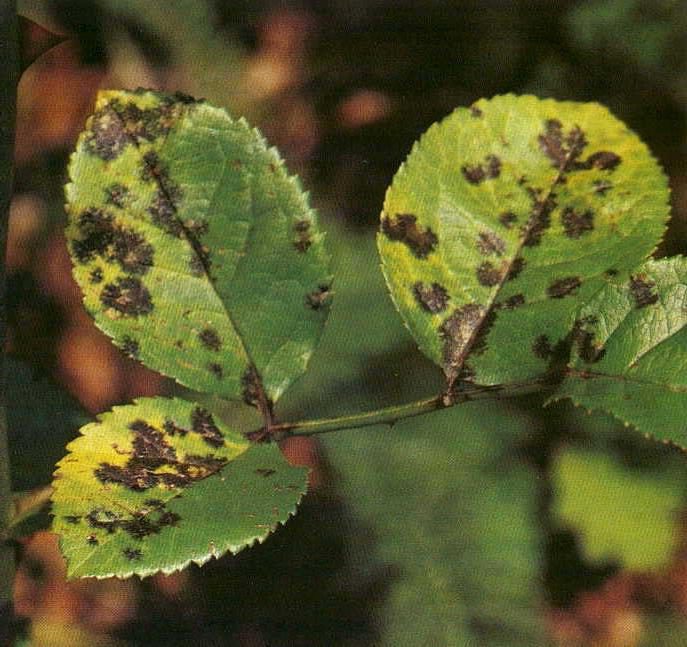

13:547 13:552
It is distributed in the spring. The leaves turn yellow and fall off, weakening the plant. Widely distributed during wet summers. This is a fungal disease that manifests itself as a black-brown spot on the leaves of roses. Usually, signs of the disease become visible in the second half of the summer. Dark brown radiant spots of various sizes are formed on the leaves, petioles and stipules. With a strong infection, the entire leaf darkens, the leaves dry out and fall off. Mycelium and spores overwinter on shoots and leaves.
13:1441
Prevention and treatment:
Removal and burning of affected leaves along with the stems, regular weeding, spraying with systemic fungicides. And also digging the soil with a turnover of the layer, autumn or early spring spraying of roses and soil before bud break with any of the permitted preparations.
13:2002 13:4
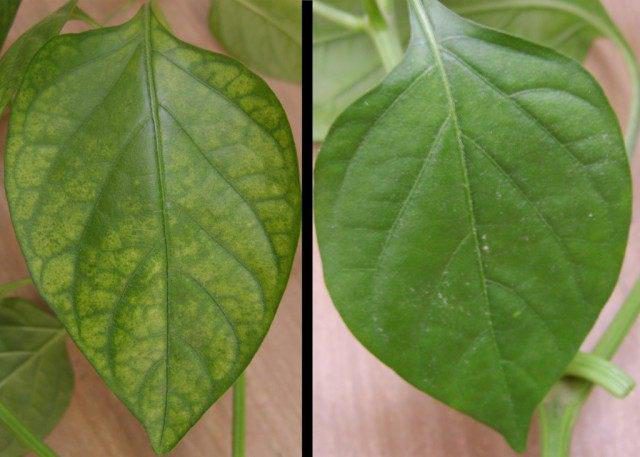

14:527 14:532
It manifests itself in whitening or yellowing of the leaves. The main reasons are the lack of iron, manganese, zinc, magnesium, boron and other elements in the soil.
14:799 14:804
For example, with a lack of iron (usually on calcareous soils) the so-called calcareous form of chlorosis develops. At the same time, the chlorotic coloration spreads almost over the entire leaf, except for the veins.
14:1173
First, the youngest are affected - the apical leaves. If the disease progresses, small veins also become discolored. The leaf becomes almost white or white with a cream shade. Subsequently, its tissues die off, the leaf falls off.
14:1603 14:4
With a lack of zinc, chlorosis spreads along the entire edge of the leaf and on the tissues between the large lateral veins.... Along the central and lateral veins, the leaf retains its green color. At the base of the veins, the green areas of the leaf are wider.
14:447 14:452
With a lack of magnesium, the lower leaves turn yellow and die off, the veins remain green, the edges of the leaves are curled.
14:659 14:664
Boron deficiency manifests itself in the light color of young leaves, they become thickened and brittle. The young growing parts are sick, the ends of the shoots (growth points) die off. Even with a slight excess of alkali, rose leaves begin to chlorosis, especially in late autumn and winter.
14:1191
Control measures:
Establish the cause of the disease as a result of soil or plant analysis. Salts of appropriate nutrients are added to the soil in prescribed doses.
14:1514 14:4
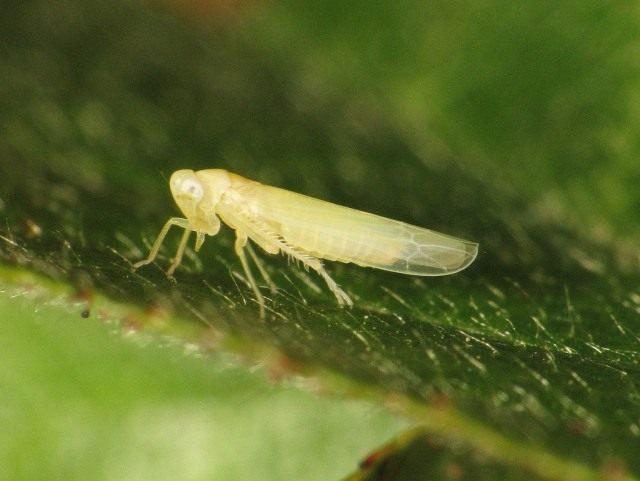

15:546 15:551
It is widespread and very harmful to the culture. The leaves are covered with small white dots, become like marble and lose their decorative effect. Severe damage from leafhoppers leads to premature yellowing and leaf fall.
15:1002 15:1007
In autumn, the female lays eggs at the ends of the shoots of roses. In spring, overwintered eggs hatch into larvae (they can be seen on the underside of the leaves). These are white, small, inactive larvae that feed on leaf sap. The body of the leafhopper is white or pale yellow, elongated.
15:1482
Adults are very mobile. At the slightest touch to the sheet, they quickly jump and fly to another place. Two or three generations develop a year.
15:1757
Prevention and treatment:
The fight against leafhoppers is most effective during the mass appearance of larvae. It is recommended to carry out two treatments with insecticides at intervals of 10-12 days with the capture of the territory adjacent to the plantings.
15:430 15:435 16:1005 16:1010
Roses infect several types of viruses, but the mosaic virus is especially common. Its signs are irregular white or yellowish spots and stripes on the leaves. This virus is spread by sucking insects.
16:1426
General advice for the prevention and control of pests
As a rule, healthy, well-developed rose bushes are less susceptible to attacks of pests, so systematic care and creation of optimal conditions will guarantee the successful cultivation of your favorite flowers. Specially developed recommendations will help to properly organize preventive measures and successfully fight against parasites that have already appeared.
- The effectiveness of pest control directly depends on the time of the beginning of the intervention. Try to introduce a permanent rule for yourself - a periodic (every 2-3 days) thorough inspection of the flower garden.
- Treatment of roses from pests includes not only spraying plants, but also watering with special solutions, in order to destroy larvae and insects in the ground. An infusion made from nettle is simultaneously used to feed plants and to prevent the appearance of aphids. For pest control, an undiluted extract of nettle infusion is used, which is sprayed with rose leaves, especially from the inside.
- In order to increase the effectiveness, periodically alternate the used remedies for rose pests - insecticides with herbal tinctures. Try to use chemicals only to destroy pests that have already appeared; for prevention, it is preferable to use folk remedies.
- You should not rely only on chemicals to kill harmful insects, you might think what to plant next to roses from pests. For example, a bush of gypsophila paniculata or lavender, planted near roses, scares off aphids and ants.
- When deciding how to treat roses from pests in the spring, be sure to take into account the temperature regime and the time of the appearance of parasite larvae. By the beginning of the period of mass appearance of larvae, it is advisable to treat the bushes with one of the insecticides.
Protection of roses from pests is a set of measures aimed at creating the most favorable conditions for plants, the basis of which is prevention. Any invasion of harmful insects is easier to prevent than to fight with them, and this requires appropriate knowledge about the structural features and lifestyle of uninvited guests of the flower garden. We hope that the publication material will be a reliable help for you and will help you organize effective care for the queen of flowers - the rose.
Prevention and treatment:
Unfortunately, there are no effective remedies, so the plant will have to be dug up and burned, the planting site should be disinfected.
16:1695
There is information that viral diseases suppress marigolds planted between roses.
16:171 16:176
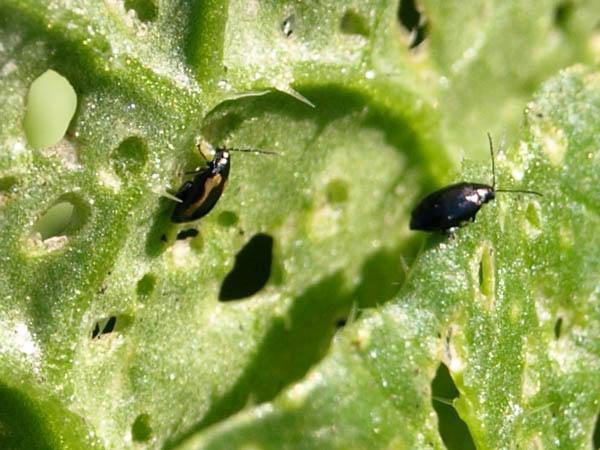

17:714 17:719
Small jumping insects that suck on leaves and form small whitish dots on their surface. May cause premature fall of foliage.Climbing roses are especially striking.
17:1053

